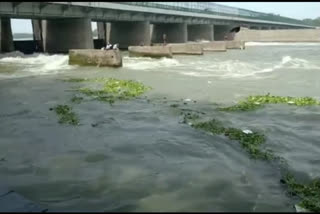New Delhi: The Central Pollution Control Board (CPCB) has asked the Delhi Jal Board (DJB) to ensure 100 per cent collection and treatment of domestic sewage generated in the city, saying untreated wastewater from 22 drains led to frothing in the Yamuna river.
Data collected in October shows that the Yamuna river water quality doesn't meet the criteria for bathing standards in the "entire Delhi stretch" except Palla village, the CPCB said in a communication to the DJB.
The apex pollution watchdog said continuous discharge of partially treated and untreated wastewater from 22 drains resulted in frothing downstream of ITO and Okhla barrage.
"Therefore, the DJB shall ensure 100 per cent collection of domestic wastewater generated in Delhi and also provide treatment as per the consented norms of the Delhi Pollution Control Committee," it said.
The CPCB also asked the DJB to ensure that no untreated domestic wastewater is discharged into any of the drains.
The water utility has been asked to adhere to the timelines set by the National Green Tribunal in September last year with respect to the Interceptor Sewer Project (ISP) and to rectify deficiencies of the existing sewage treatment plants (STPs).
Earlier, sewage water from unauthorised colonies would run directly into the three main drains in the city -- Najafgarh, Supplementary and Shahdara -- that flow into the river.
The ISP blocks waste water from unauthorised colonies and divert it to nearby STPs that releases the treated effluent into the main drains, reducing pollution in the Yamuna.
Visuals of toxic froth floating on the surface of the Yamuna river near Kalindi Kunj in Delhi made their way back to social media recently, with experts citing detergents as one of the major reasons behind the pollution.
Majority of the detergents in the country don't have a certification by the ISO (International Organization for Standardization), which has capped the concentration of phosphates in the chemical substance, an official of the CPCB had said.
The primary reason behind the formation of the toxic foam was high phosphate content in the wastewater because of detergents used in dyeing industries, ''dhobi'' ghats and households, according to the official.
"A large number of unbranded detergents are also used in households and dyeing industries. The wastewater containing high phosphate content reaches the river through untapped drains," he had said.
